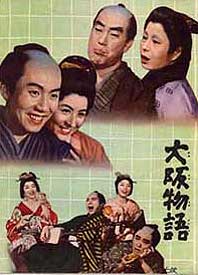 Kenji Mizoguchi was set to direct his own adaptation of a Seikaku sexual satire of the Tokugawa period, An Osaka Story aka Greed (Osaka monogatari, 1957).
Kenji Mizoguchi was set to direct his own adaptation of a Seikaku sexual satire of the Tokugawa period, An Osaka Story aka Greed (Osaka monogatari, 1957).
Kozaburo Yoshimura undertook the project after Mizoguchi's death. It's still usually placed in Mizoguchi's filmography because he reworked the Ihara Saikaku story before giving it over to a screenwriter.
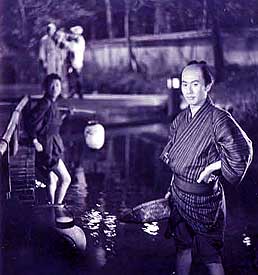 Saikaku (1642-1693) was one of the greatest writers of the Tokugawa era, who wrote many social satires of the pleasure district, with a particular interest in crime & detection, sex including sexual deviance in which Saikaku delighted. His obsessions have left his peculiar short stories seemingly modern. Saikaku (1642-1693) was one of the greatest writers of the Tokugawa era, who wrote many social satires of the pleasure district, with a particular interest in crime & detection, sex including sexual deviance in which Saikaku delighted. His obsessions have left his peculiar short stories seemingly modern.
Raizo Ichikawa was famous for his gloomy, gloomy roles, but An Osaka Story gives him a chance at satiric comedy.
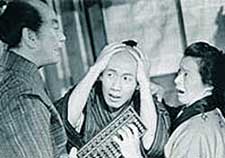 He plays a humble store clerk in love with his boss's daughter (Kyoko Onatsu). The girl's father had been impoverished in his youth & though he became well-off, he has a veritable mania about money, & the idea of his daughter marrying the clerk horrifies him. He plays a humble store clerk in love with his boss's daughter (Kyoko Onatsu). The girl's father had been impoverished in his youth & though he became well-off, he has a veritable mania about money, & the idea of his daughter marrying the clerk horrifies him.
Unfortunately, his choice of ideal husband (Shintaro Katsu) turns out to be a devil-may-care habitue of the pleasure district.
Though in essence a satire on capitalism in a rapidly changing era, there are many grotesquely sad incidents, including the fate of the increasingly tight-fisted father who finally loses his mind.
From the social relevance novel Hakai (1906; available as a Japan Foundation translation titled The Broken Commandment) by Toson Shimazaki, the film version of Hakai (1962) on the rare occasions when shown in the United States is generally titled The Outcast. It has also carried the English titles The Broken Commandment, The Sin or Apostasy.
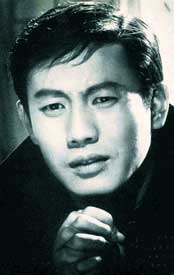 The meiji-mono genre of tales of the Meiji era are often about "the weak hero." So it is not surprising to find here a hero who struggles to overcome his own dishonesty & hypocrisy with the people he cares about. Raizo takes the character from a place of deep though aesthetic gloom to the height of poetic heroism. The meiji-mono genre of tales of the Meiji era are often about "the weak hero." So it is not surprising to find here a hero who struggles to overcome his own dishonesty & hypocrisy with the people he cares about. Raizo takes the character from a place of deep though aesthetic gloom to the height of poetic heroism.
Raizo plays an eta or member of the burakumin (untouchables community), a very low caste of people of Korean descent in Japan, who historically specialized in carrion & garbage disposal, leather work, meat butchering, & sundry occupations with a certain horror attached to them by Shinto belief, so that only outcastes would specialize in such work.
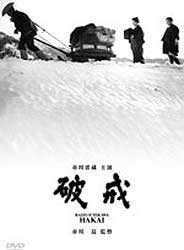 Even today when laws make it illegal to discriminate against burakumin, the pejorative term eta is still whispered. Even today when laws make it illegal to discriminate against burakumin, the pejorative term eta is still whispered.
Buraku families still tend to live in their own neighborhoods; still frequently adhere to traditional occupations dealing with meat, leather, or the dead; & remain isolated from the mainstream of Japanese society or held back from advancement in salaryman culture no matter their competence.
At the beginning of the previous century, when Hakai is set, the prejudice was very deep seated & overt, though even in the Tokugawa period, kabuki plays sentimentalized the hardships of burakumin experiencing doomed love outside their caste.
Ushimatsu Segawa (Raizo) has been able to "pass" as a normal Japanese student to evade the intense social stigma placed on eta. His father (Jun Hamamura), having suffered from prejudice his whole life, on his deathbed extracted from Ushimatsu an oath to leave his home village & always hide his origins, never looking back.
As a school teacher, his very ability to make a living would come to a halt were his heritage to become known. He falls in love with Oshino (Raizo's most recurring leading lady, Shiho Fujimura), the daughter of a priest (Ganjiro Nakamura), but represses his feelings because of his secret.
He is befriended by an eta activist & author, Rentaro Inoko (Rentaro Mikuni), who Ushimatsu greatly admires. Yet even to Inoko he denies his own heritage. At a critical moment in their friendship, Ushimatsu even denies that he knows Inoko, who is heartsick at his friend's weakness.
When Inoko is murdered, Ushimatsu has a veritable epiphany & risks all to reveal his background, for he now sees it as his duty to become "the new Inoko," carrying on the great man's struggle against prejudice.
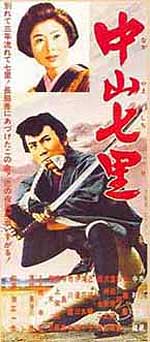 Kiba-no-Masakichi, Masa for short, is a lumber worker who falls in love with Oshima (Tamao Nakamura) almost at first sight, in The One & Only Girl I Ever Loved (Nakayama shichiri, 1962). Kiba-no-Masakichi, Masa for short, is a lumber worker who falls in love with Oshima (Tamao Nakamura) almost at first sight, in The One & Only Girl I Ever Loved (Nakayama shichiri, 1962).
The English title was a weak one for its first US release, for The Only Girl I Ever Loved implied a love story rather than a film with excellent swordplay. Although it is partially a costume love story comes very close to being the sort of ninkyo eiga or chivalrous gambler film that dominated the screens of the 1960s.
Its title in the UK was a bit better, Seven Miles from Nakayama, which is a standard poetic reference to a village in the Hida district with mountains extremely close. Thus the film has also been known as In a Ring of Mountains.
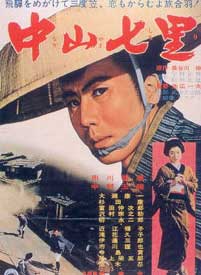 Based on a novel by Shin Hasegawa, Nakayama shichiri was already twice filmed in 1930, one version directed by Namio Ochiai & from which less than 40 minutes survive, the other directed by Kyotaro Namiki. Both are silent films, preserved by the Makino film institute. Based on a novel by Shin Hasegawa, Nakayama shichiri was already twice filmed in 1930, one version directed by Namio Ochiai & from which less than 40 minutes survive, the other directed by Kyotaro Namiki. Both are silent films, preserved by the Makino film institute.
When a corrupt magistrate rapes Oshima, Masa (Raizo Ichikawa) avenges her by killing the officer, becoming thereby a fugitive, haunted & grief-stricken by the fact that Oshima committed suicide.
Going underground in the gambling world, perpetually hiding from the law, Masa eventually meets a young woman named Onaka, who looks exactly like Oshima. Tales having two look-alike heroines are a commonplace in Japanese period films, a plot affectation inherited from the kabuki theater.
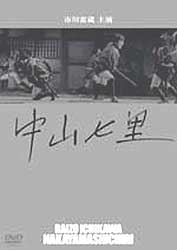 Though Onaka is the girlfriend of Masa's friend Toku (Koichi Ose), she nevertheless finds herself falling for Masa, a feeling that he cannot squash even by rudling telling her she only looks like the woman he loved, she is not that woman. Though Onaka is the girlfriend of Masa's friend Toku (Koichi Ose), she nevertheless finds herself falling for Masa, a feeling that he cannot squash even by rudling telling her she only looks like the woman he loved, she is not that woman.
Still pursued by the law, he's finally cornered by Tohachi (Yasushi Sugita), for a climactic one-against-all battle.
As with classic ninkyo eiga it moves slowly but inexoribly toward the last reel's violent eruption; & like ninkyo eiga the hero's sense of himself as wandering outcast does not permit him any chance at lasting relationships.
Director Kazuo Ikehiro would later direct Raizo in the Full Moon Swordsman films Nemuri Kyoshiro: Joyoken (Nemuri at Bay, 1964) Nemuri Kyoshiro: Burai-Hikae masho no hada (A Trail of Traps, 1967), Nemuri Kyoshiro: Akujo-gari (Castle Menagerie, 1969) Nemuri Kyoshiro manji giri (The Flyfot Swordsman, 1969), as well as directing Shintaro Katsu in Zatoichi films.
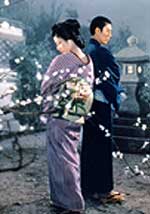 Another Raizo film from a literary source is based on Kyoka Izumi's Onna Keizu (Women's Genealogy, 1907). Another Raizo film from a literary source is based on Kyoka Izumi's Onna Keizu (Women's Genealogy, 1907).
Her Hidden Past (Onna Keizu, 1962) was not the first film adaptation. It was also filmed in 1934 directed by Hotei Namura, remade in 1942 as a two-film set directed by Masahiro Makino, & again in 1955 directed by Teinosuke Kinugasa.
The 1962 version is by Kenji Misumi, another director who would direct episodes of the Full Moon Swordsman/Sleepy Eyes of Death & the Zatoichi/Blind Swordsman series
Raizo plays Chikara Hayasi, & Masayo Banri plays the ex-geisha Otsuta with whom he has a socially unacceptable affair.
He is not permitted to marry Otsuta due to her past, though his own history is also checkered, for he was fostered by a professional pickpocket & had been a little thief in his childhood.
When Otsuta is found to be an unsuitable mate, there is more than a little veiled insult when she self-defensively insists, "Even thieves can change!"
A three-hanky weeper, everything from broken hearts to tuberculosis to homicide-suicide drags down the characters in this no-hope-for-anyone tale, for in Japan's golden age of cinema no degree of sadness was too tragic for popular consumption.
copyright © by Paghat the Ratgirl
|
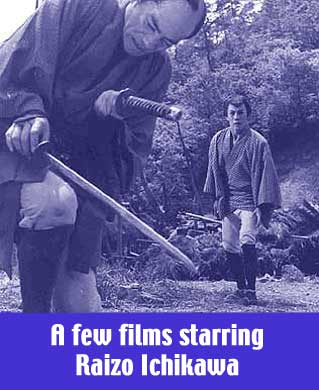

 Saikaku (1642-1693) was one of the greatest writers of the Tokugawa era, who wrote many social satires of the pleasure district, with a particular interest in crime & detection, sex including sexual deviance in which Saikaku delighted. His obsessions have left his peculiar short stories seemingly modern.
Saikaku (1642-1693) was one of the greatest writers of the Tokugawa era, who wrote many social satires of the pleasure district, with a particular interest in crime & detection, sex including sexual deviance in which Saikaku delighted. His obsessions have left his peculiar short stories seemingly modern. He plays a humble store clerk in love with his boss's daughter (Kyoko Onatsu). The girl's father had been impoverished in his youth & though he became well-off, he has a veritable mania about money, & the idea of his daughter marrying the clerk horrifies him.
He plays a humble store clerk in love with his boss's daughter (Kyoko Onatsu). The girl's father had been impoverished in his youth & though he became well-off, he has a veritable mania about money, & the idea of his daughter marrying the clerk horrifies him. The meiji-mono genre of tales of the Meiji era are often about "the weak hero." So it is not surprising to find here a hero who struggles to overcome his own dishonesty & hypocrisy with the people he cares about. Raizo takes the character from a place of deep though aesthetic gloom to the height of poetic heroism.
The meiji-mono genre of tales of the Meiji era are often about "the weak hero." So it is not surprising to find here a hero who struggles to overcome his own dishonesty & hypocrisy with the people he cares about. Raizo takes the character from a place of deep though aesthetic gloom to the height of poetic heroism. Even today when laws make it illegal to discriminate against burakumin, the pejorative term eta is still whispered.
Even today when laws make it illegal to discriminate against burakumin, the pejorative term eta is still whispered.
 Based on a novel by Shin Hasegawa, Nakayama shichiri was already twice filmed in 1930, one version directed by Namio Ochiai & from which less than 40 minutes survive, the other directed by Kyotaro Namiki. Both are silent films, preserved by the Makino film institute.
Based on a novel by Shin Hasegawa, Nakayama shichiri was already twice filmed in 1930, one version directed by Namio Ochiai & from which less than 40 minutes survive, the other directed by Kyotaro Namiki. Both are silent films, preserved by the Makino film institute. Though Onaka is the girlfriend of Masa's friend Toku (Koichi Ose), she nevertheless finds herself falling for Masa, a feeling that he cannot squash even by rudling telling her she only looks like the woman he loved, she is not that woman.
Though Onaka is the girlfriend of Masa's friend Toku (Koichi Ose), she nevertheless finds herself falling for Masa, a feeling that he cannot squash even by rudling telling her she only looks like the woman he loved, she is not that woman.